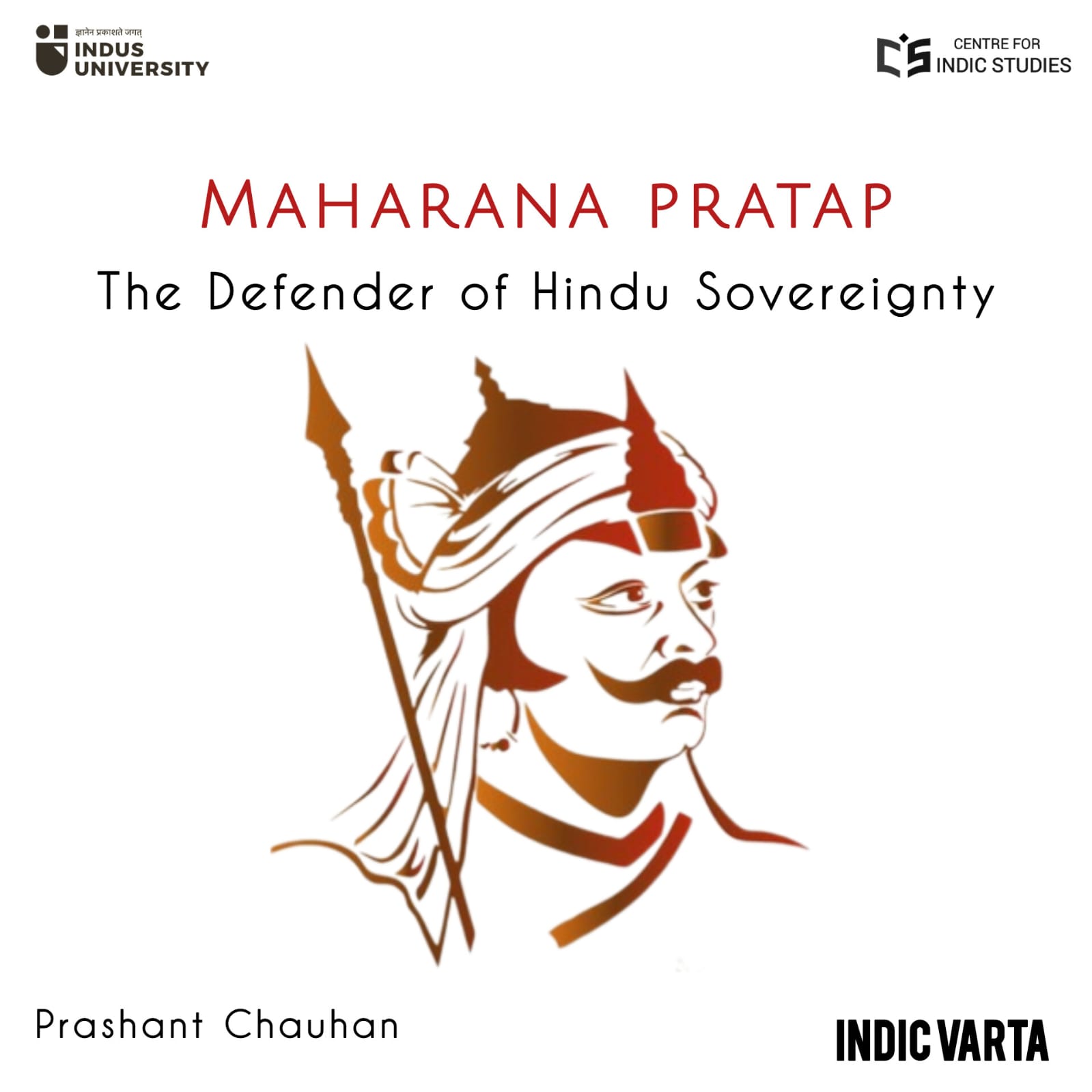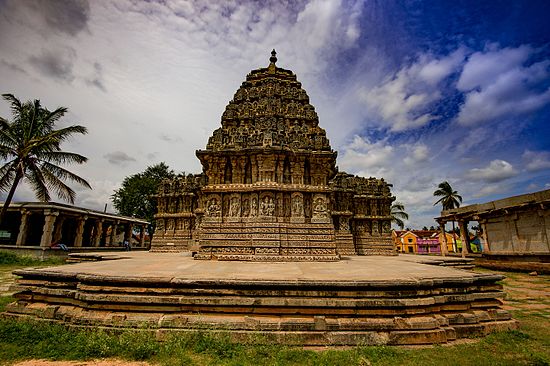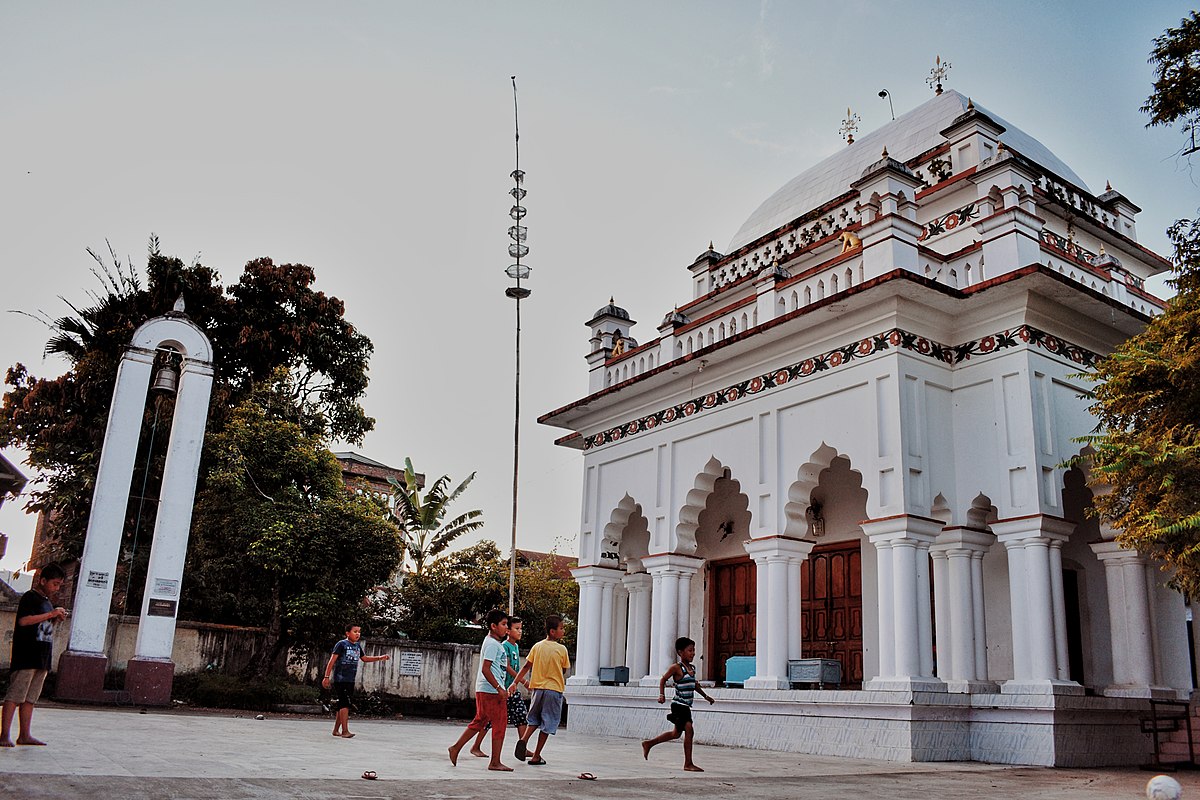- Visitor:898
- Published on: 2025-05-09 04:05 pm
Maharana Pratap: The Defender of Hindu Sovereignty
Maharana Pratap's name is immortal in history for his valor, heroism, sacrifice, determination, and unmatched courage. He refused to accept the sovereignty of the Mughal emperor Akbar and engaged in years of relentless struggle. After the demise of Maharana Udai Singh II, Maharana Pratap ascended the throne of Mewar in 1572. However, his path was fraught with challenges, both internal and external. Maharana Pratap’s life exemplified the ideals of loyalty, patriotism, and sacrifice. He valued his people's welfare above personal comfort and even endured hardship to ensure their freedom. His trusted horse, Chetak, is celebrated for its loyalty and bravery in the Battle of Haldighati.

Indian history is replete with tales of heroism, sacrifice, and unwavering dedication to the protection of the nation’s culture, religion, and sovereignty. Among the warriors who upheld the honor of the land, the Kshatriyas hold a revered place, embodying bravery and selflessness in times of both peace and war. Their sacrifices were not just for their kingdoms but for the preservation of dharma and the cultural fabric of India. Maharana Pratap, the Lion of Mewar, stands as a shining example of this noble spirit, whose life was a saga of resistance, courage, and relentless devotion to his motherland.
The Sacrifices of the Kshatriyas
Throughout history, the Kshatriyas have always prioritized their sacrifices for the protection of religion, society, and civilization. For centuries, the land of India has valiantly fought to preserve its values and independence against numerous foreign invaders. The stories of great Kshatriya kings who sacrificed their lives for the preservation of India are etched in golden letters in Indian scriptures. These benevolent rulers waged countless battles to protect their people and sovereignty, often enduring severe injuries and attaining martyrdom.
Maharana Pratap stands among the great warriors of Indian history whose unparalleled bravery and unwavering dedication to freedom have immortalized him. He was a prominent ruler of Mewar who chose a life of hardship in the forests rather than bowing before the Mughal emperor Akbar. Maharana Pratap was not only a valiant warrior but also a devoted patriot, always ready to lay down his life for the defense of his Motherland. His life epitomizes sacrifice, struggle, and indomitable courage. The Battle of Haldighati, in which he valiantly faced the massive Mughal army, is a glorious chapter in Indian history. His resolute determination and deep love for freedom continue to inspire every Indian to this day. Maharana Pratap’s life conveys the message that no sacrifice is too great for the honor and independence of one’s motherland.
Maharana Pratap: The Lion of Mewar
Maharana Pratap was born in the present-day Kumbhalgarh region of Rajasthan to Maharana Udai Singh and Queen Jaiwanta Bai on May 9, 1540 according to the Julian calendar. This date is also known as Jyeshtha Shukla Tritiya in the Hindu calendar. In 2025, this corresponds to May 29th. According to author James Tod, his birthplace was Kumbhalgarh in Mewar, while historian Vijay Nahar suggests, based on Rajput traditions and Maharana Pratap’s birth chart, that he was born in the royal palace of Pali. Maharana Pratap belonged to the Sisodia clan of Rajputs, known for their warrior ethos and commitment to protecting their kingdom. His coronation marked the beginning of a relentless struggle against the Mughals, who sought to bring Mewar under their control.
His name is immortal in history for his valor, heroism, sacrifice, determination, and unmatched courage. Maharana Pratap refused to accept the sovereignty of the Mughal emperor Akbar and engaged in years of relentless struggle. After the demise of Maharana Udai Singh II, Maharana Pratap ascended the throne of Mewar in 1572. However, his path was fraught with challenges, both internal and external. Maharana Pratap’s life exemplified the ideals of loyalty, patriotism, and sacrifice. He valued his people's welfare above personal comfort and even endured hardship to ensure their freedom. His trusted horse, Chetak, is celebrated for its loyalty and bravery in the Battle of Haldighati.
Foreign Invasions and Their Impact on India
India has faced numerous invasions from foreign powers. To put it mildly, India was often a preferred destination for invaders due to its immense wealth, agricultural prosperity, thriving spice trade, fertile river valleys, and abundant human resources. These invaders sought to exploit India’s riches and make it a colony for their own gain. The foreign onslaughts not only plundered India’s material wealth but also inflicted significant damage on its cultural and religious fabric. Among these, the invasions by the Turks and Mughals had the most profound and lasting impact on the Indian populace.
The Mughal invasions, in particular, left a lasting imprint on the country. Internal struggles for succession among the Mughal rulers created prolonged periods of instability. Rampant corruption within their administration eroded the trust of the people in governance. The Mughal economy’s heavy reliance on agriculture exacerbated the plight of farmers, who were burdened with excessive taxes, pushing them into deeper economic distress. Moreover, the Mughal rulers prioritized their extravagant lifestyles over the welfare of the common people, further worsening the conditions of the masses.
The Mughals, much like the British later, adopted the policies of Saam, Daam, Dand, Bhed (persuasion, monetary incentives, punishment, and division) to subjugate the Rajput kings and expand their empire. Many rulers succumbed to greed and voluntarily accepted Mughal suzerainty, while others were defeated in battles, leading to the annexation of their kingdoms. The Mughal Empire established widespread imperial control over the Indian subcontinent, leaving a profound impact on Indian culture on one hand, while simultaneously destroying several regional traditions and practices on the other.
The religious intolerance of rulers like Aurangzeb led to the destruction of numerous Hindu temples and the abandonment of policies promoting religious harmony, resulting in unrest among different communities. The military campaigns of the Mughals caused widespread devastation in cities and regions, disrupting traditional practices and religious beliefs. Their approach to religion was mixed, oscillating between religious tolerance and outright fanaticism. from the 7th century, starting with the Islamic invader Muhammad bin Qasim to the last Islamic ruler Bahadur Shah Zafar, India has borne the consequences of the relentless attacks on its Hindu civilization.
For over five centuries, forces sponsored by the Islamic Caliphates of Arabia launched continuous invasions on Hindu rulers. Like Mewar, kingdoms such as Sindh, Chandela, Pratihara, Shahiya, Vijayanagara, Kakatiya, Ahom, Maratha, and Kalinga, among others, waged campaigns against the Mughals. These kingdoms not only sacrificed their kings for the preservation of sovereignty and dharma but also witnessed the heroic contributions of courageous queens and patriotic citizens, who willingly laid down their lives for the cause of their nation and faith.
The Beginning of a Legacy: Maharana Pratap’s Coronation
The Kshatriya dynasties often faced greater internal discord and familial conflicts over power and succession than threats from external invaders. These internal disputes frequently weakened royal households, providing opportunistic invaders with the perfect chance to exploit and destabilize the kingdom. Maharana Pratap, too, endured similar challenges during his time.
Despite these adversities, Maharana Pratap chose to rise above the lure of power and material wealth, maintaining his equanimity and steadfastness. This unwavering resolve and commitment to principles led to Maharana Pratap being crowned twice—first on February 28, 1572, in Gogunda, and later the same year at the formidable Kumbhalgarh Fort. These events highlight his dedication to upholding the values of leadership and the legacy of Mewar. Before his death, Rana Udai Singh had declared his youngest son, Jagmal, as his successor, despite Maharana Pratap being older than Jagmal. Maharana Pratap was willing to renounce his claim and leave Mewar for the sake of his younger brother. However, the nobles and chieftains of Mewar were not in agreement with this decision.
After much deliberation, it was collectively decided that Jagmal would have to relinquish the throne. Respecting the wishes of the chieftains and the people, Maharana Pratap accepted the responsibility of leading the kingdom of Mewar. Thus, Maharana Pratap, the illustrious grandson of Rana Sanga and a proud symbol of Rajput valor and honor, ascended the throne on March 1, 1573 CE (Vikram Samvat 1628, Phalguna Shukla 15). His coronation took place in Gogunda, marking the continuation of the glorious legacy of the Sisodia dynasty established by Bappa Rawal.
Protectors and Betrayers of the Mother-land
Maharana Pratap’s life and deeds are profoundly defined by his lifelong struggle against the Mughal invader Akbar and his ultimate triumph in preserving the honor of his land. During Maharana Pratap’s era, the Mughal emperor Akbar ruled Delhi. The Mughals followed a strategy of using the strength of Hindu kings to subjugate other Hindu rulers and bring them under their control. After Akbar had Hemu beheaded, it became evident to him that Hindus could not be easily subjugated to Islam. Recognizing this resistance, Akbar adopted a façade of tolerance and brotherhood. He began incorporating Hindu ministers and prominent individuals into his court, a move designed to erode the sovereignty of Hindu states and bring them under his imperial ambitions. With Akbar's rise to power, Hindus were confronted with a new form of adversary—a ruler who cleverly altered his strategies, exploiting internal divisions and greed to pit Hindus against each other. History bears testimony that whenever a nationalist Hindu king fought valiantly for the freedom of his motherland, betrayal from within his own realm often became the cause of setbacks. Among such betrayers, Raja Man Singh holds a prominent place.
Man Singh, the king of Amber (modern-day Jaipur), is remembered as one who prioritized allegiance to the Mughal Empire over loyalty to his homeland. As a member of the illustrious Rajput tradition, he is a controversial figure for having compromised the independence and dignity of his people. Under Akbar’s command, Man Singh participated in several key military campaigns, including leading the Mughal forces in the Battle of Haldighati (1576) against Maharana Pratap.
The Battle of Haldighati stands as a pivotal chapter in Indian history, where two factions of Rajputs faced each other. On one side was Maharana Pratap, fighting to preserve the freedom of his Motherland, and on the other was Man Singh, dutifully executing Akbar’s orders. Man Singh’s actions are often perceived as weakening the Rajput resistance against the Mughal Empire, undermining the struggle for independence, and compromising the honor of his homeland.
Akbar rewarded Man Singh with significant privileges and authority within the Mughal Empire. He elevated Man Singh to a prominent position in his court and entrusted him with the administration of key territories such as Kabul, Bengal, and Bihar. Man Singh was also made one of Akbar’s esteemed Navratnas and was appointed to high-ranking military posts.by bestowing wealth, power, and prestige upon Man Singh, Akbar successfully lured him into loyal service. This allure proved so compelling that Man Singh chose to stand against his fellow Rajputs, prioritizing the service of the Mughal Empire over the unity and independence of his people. This act of allegiance to a foreign power was not only a personal compromise but also a deeply divisive move for the Rajput community, casting a long shadow on their collective legacy.
In conclusion, Maharana Pratap’s steadfast resistance to Akbar’s imperial ambitions and Man Singh’s allegiance to the Mughal court symbolize the contrasting paths chosen by leaders of the time. Where Pratap’s resolve represents unyielding dedication to the sovereignty of his motherland, Man Singh’s actions epitomize the divisive impact of greed and ambition exploited by foreign powers. This historical episode serves as a poignant reminder of the importance of unity and the perils of betrayal from within.
The Rajputs fought relentlessly to protect their pride and sovereignty, often sacrificing their lives for their homeland. These warrior Rajputs bore an intense disdain and fiery rage toward the Mughal efforts to destroy Indian culture. While some succumbed to greed and aligned themselves with the Mughal Empire, figures like ‘Ram Prasad’ and ‘Chetak’– faithful companions of their masters– sacrificed their lives for the cause of freedom. The Battle of Haldighati stands as a monumental clash: on one side was Akbar, driven by imperialistic ambition, whose dynasty was marked by familial betrayals for power; on the other was Maharana Pratap of Mewar, who dedicated his life to protecting his sovereignty and faith.
Ethical Warfare of Maharana Pratap
The Mughals, consumed by their desire for expansion, resorted to extreme measures to achieve their goals. Their indulgence in luxury often came at the expense of the innocent, leaving countless women and children exploited in their conquests. In stark contrast, Hindu rulers who opposed Mughal tyranny upheld the principles of ethical warfare. Rajputs adhered to strict codes of battle, refraining from attacking unarmed or surrendered foes, sparing Brahmins, charioteers, and non-combatants, halting hostilities after sunset, and treating even their enemies with honor after hostilities ceased.
While the Mughals violated women and pillaged the lands they conquered, the Rajputs exemplified valor and chivalry. After the battle, they released Mughal women with honor and dignity. One notable instance involved Amar Singh Kunwar capturing the daughter and female relatives of Khan-e-Khana during a raid. Upon learning of this, Maharana Pratap reprimanded Amar Singh. Following the Maharana’s orders, Amar Singh had these women tie Rakhi on his wrist as a mark of respect and returned them safely to Khan-e-Khana’s camp.
This adherence to honor and ethics, however, was often exploited by the Mughals. Yet, the Rajputs remained steadfast in their principles, fighting every battle with integrity and loyalty to their values. This juxtaposition highlights the stark differences between the Rajputs, who revered honor, and the Mughals, whose actions were often driven by avarice and indulgence.
Conclusion
The legacy of Maharana Pratap and the sacrifices of the Kshatriyas are enduring testaments to India’s rich cultural heritage and unyielding spirit of resistance. Their unwavering commitment to dharma, freedom, and the preservation of their motherland continues to inspire generations. Maharana Pratap’s life, marked by indomitable courage and unflinching devotion to his people, exemplifies the true essence of leadership and patriotism. Through relentless battles, unthinkable hardships, and steadfast loyalty to their values, the Kshatriyas upheld the dignity and sovereignty of their land. Their sacrifices remind us of the importance of unity, the perils of internal divisions, and the need for steadfastness in the face of external aggression.
- 449 min read
- 1
- 0










